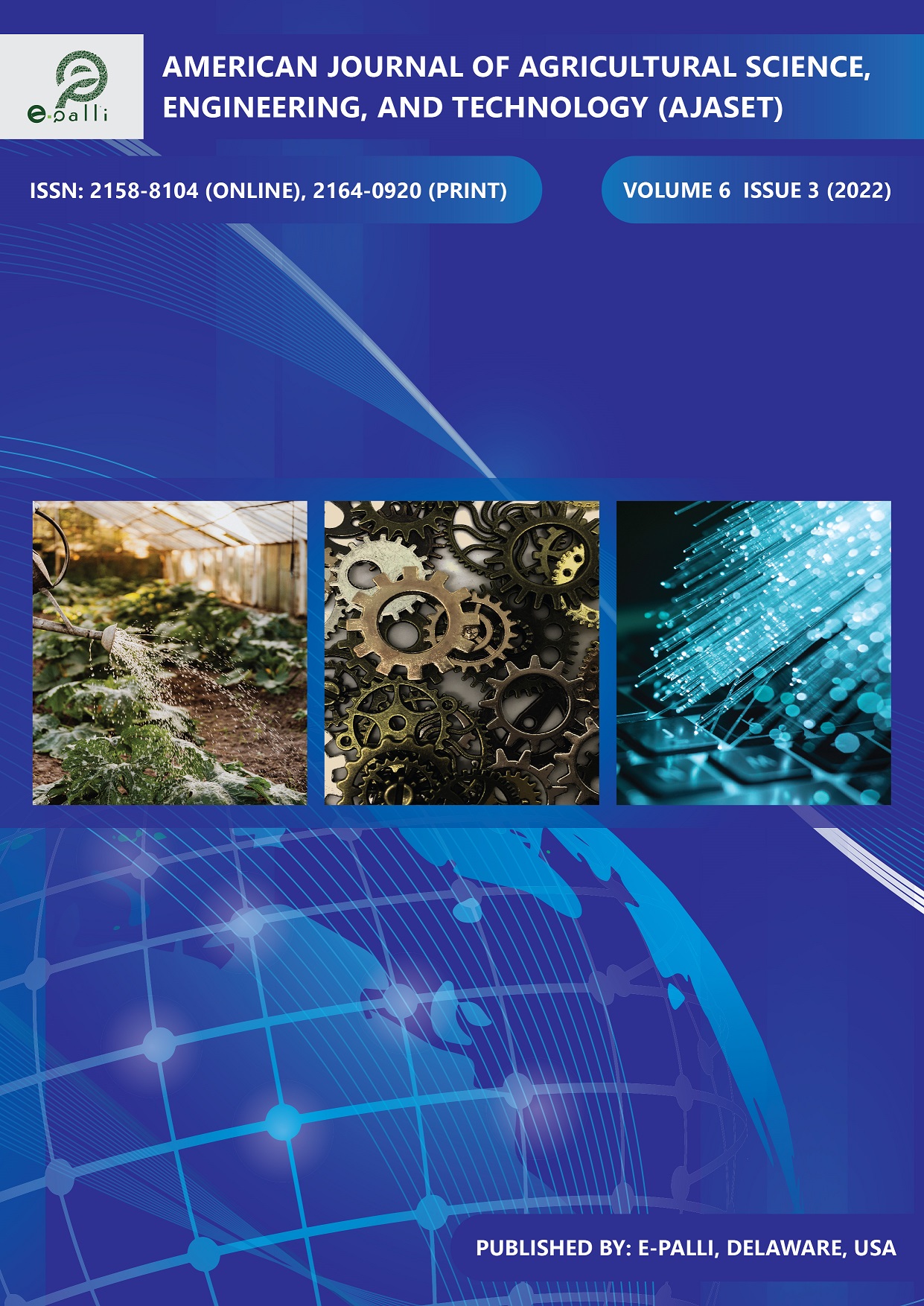Effect of Genotypes and De-Topping on Growth and Yield of Okra
DOI:
https://doi.org/10.54536/ajaset.v6i3.917Keywords:
De-Topping, Okra Genotypes, Apical Parts, Individual Pod Weight and YieldAbstract
A field experiment was conducted at the experimental field of the Department of Horticulture in Sylhet Agricultural University to evaluate the growth and yield performance of three okra genotypes (viz. BARI Dherosh-1, BARI Dherosh-2 & RAJ F1) under special management practices (viz. de-topping & non de-topping) from March to July 2022. The two factor experiment was laid out in a Randomized Complete Block Design (RCBD) with three replications. BARI Dherosh-1 showed vigorous growth nature having maximum yield and yield contributing characters viz. the highest plant height (20.46 cm) at 30 DAS (Days After Sowing) and at 1st harvest (108.23 cm ), early flowering (51.33 days), the maximum number of leaves per plant (4.71), number of branches (2.96), number of pods per plant (43.80), the highest individual pod weight (20.96 g), pod yield per plant (916.75 g) as well as per hectare yield (30.53 t) than the other two genotypes. Contrary, the lowest individual pod weight (18.80 g), pod yield per plant (638.72 g), and per hectare yield (21.28 t) were produced by genotype RAJ F1. Due to removing apical parts at 30 DAS, the shortest plants were observed in the de-topping system (85.69 cm). Again, Individual pod weight (20.87 g), pod yield per plant (887.95 g), and per hectare yield (29.57 t) were higher in non de-topping system than the de-topping system. Considering the interaction effect, BARI Dherosh-2 performed better under non de-topping system having the highest pod breadth (2.05 cm) and pod yield per plant (1007.86 g) and per hectare yield (33.56 t). Actually, de-topping at 30 DAS had no beneficial effect on yield or yield contributing characters. So, BARI Dherosh-2 might be recommended for the Sylhet region to ensure maximum benefit without de-topping.
Downloads
References
Adenle-Saheed, V. O., Oso, Y. A. A., Adebanwo, I. T., & Adetayo, O. O. (2016). Effect of Apex Removal and Different Spacing on Growth and Yield of Capsicum Frutescence. Lagos State Polytechnic School of Agriculture, 65.
Aikins, K.A., Najombu, T., & Msibi, S.T. (2017). Effect of Apical Pinching on the Performance of Asontem Okra. World Journal of Agricultural Sciences, 13 (2), 68-74. DOI: 10.5829/idosi.wjas.2017.68.74
Ali, A., Nabi, G., Khan, M. I. M. N., Israr, M., Ali, S., Rehman, J., & Ali, W. (2021). 15. Pinching effects on growth and yield of okra. Pure and Applied Biology (PAB), 11(1), 135-145.
Ashraf, A. T. M., Rahman, M. M., Hossain, M. M., & Sarker, U. (2020). Performance evaluation of some selected okra genotypes. Intl. J. Plant Soil Sci., 32, 13-20.
Ayarna, A. W., Tsukagoshi, S., Nkansah, G. O., & Maeda, K. (2019). Effect of Spacing and Topping on the Performance of Hydroponically Grown Tomato Under Tropical Conditions. Journal of Agriculture and Crops, 5(2), 23-30.
Aydin, I., & Arslan, S. J. I. C. (2018). Mechanical properties of cotton shoots for topping. Ind. Crops Prod., 112, 396–401.
Bagasol, J. M., Bistayan, F. B., & Busiguit, S. D. (2019). Effect of Topping Schedules on the Growth and Yield Parameters of Lady’s Finger (Abelmoschus esculentus). Indian Journal of Science and Technology, 12(27).
BARC. (2005). Fertilizer Recommendation Guide. Bangladesh Agricultural Research Council. Farmgate, New Airport Road, Dhaka. (p.p.119).
BBS (Bangladesh Bureau of Statistics) (2021). Year book of Agricultural statistics of Bangladesh. Government of the People’s Republic of Bangladesh.
Buczkowska, H. (2010). Effect of plant pruning and topping on yielding of eggplant in unheated foil tunnel. Acta Sci. Pol. Hortorum Cultus, 9, 105–115.
Chanda, S. C., Khan, M. J., Sarkar, S. C., & Ruhul, M. (2020). Problems, Prospects and Profitability Analysis of High Value Summer Vegetables Cultivation in Sirajganj District. Bangladesh Journal of Extension Education, 32.
Das, H., Poddar, P., Haque, S., Pati, S., Poddar, R., & Kundu, C. K. (2014). Seed yield and economics of white jute as influenced by different dates of sowing, spacing and topping schedule in Terai region of West Bengal. Int. J. Farm Sci., 4, 51–58.
Firoz, Z. A., Nasiruddin, K. M., Mondal, M. F., & Farooq, A. M. (2010). Growth and yield of okra as influenced by hill elevation and plant de-detoping in hill slope condition. Bangladesh Journal of Agricultural Research, 35(2), 355-358.
Gemede, H. F., Ratta, N., Haki, G. D., Woldegiorgis, A. Z., & Beyene, F. (2015). Nutritional quality and health benefits of okra (Abelmoschus esculentus): A review. J Food Process Technol., 6(458), 2.
Gopal, M., Durairaj, S. N., Sureshkumar, R., & Marimuthu, S. (2016). Influence of topping and nutrient management practices on growth and seed yield of dhaincha (Sesbania aculeata). Agricultural Science Digest-A Research Journal, 36(4), 315-318.
Hazra, P. (2008). Upgradation of the vegetable production scenario of Bangladesh: suggested strategy. J. Agrofor. Environ, 2(2), 201-204.
Islam, M.S., Rahman, M.M., & Ali, M. (2000). Off season production of okra as affected by sowing time. Ann. Bangladesh Agric., 10 (1), 105-112.
Maurya, R. P., Bailey, J. A., & Chandler, J. S. A. (2013). Impact of plant spacing and picking interval on the growth, fruit quality and yield of okra (Abelmoschus esculentus (L.) Moench). American Journal of Agriculture and forestry, 1(4), 48-54.
National Research Council (US). (2006). Transportation Research Board. Committee for the National Tire Efficiency Study. Tires and passenger vehicle fuel economy: informing consumers, improving performance, 286.
Oyelade, O. J., Ade-Omowaye, B. I. O., & Adeomi, V. F. (2003). Influence of variety on protein, fat contents and some physical characteristics of okra seeds. Journal of Food Engineering, 57(2), 111-114.
Priyanka, V. M., Reddy, T., Begum, H., Sunil, N., & Jayaprada, M. (2018). Studies on genetic variability, heritability and genetic advance in genotypes of okra [Abelmoschus esculentus (L.) moench]. International Journal of Current Microbiology and Applied Sciences, 7, 401-411.
Rahman, M., Islam, A. F. M. S., Hasan, M., & Uddin, M. (2020). Growth and yield performance of okra genotypes in acidic soil at Sylhet Region, Bangladesh. Archives of Agriculture and Environmental Science, 5(3), 283-291.
Rashid, M. M. (1999). Shabji bijjayan (In Bengali). Rashid Publishing House, 94, Old DOHS, Dhaka-1206. (p.p. 476).
Reddy, M. T., Begum, H., Sunil, N., Rao, P. S., Sivaraj, N., & Kumar, S. (2014). Preliminary characterization and evaluation of landraces of Indian spinach (Basella spp. L.) for agro-economic and quality traits. Plant Breeding and Biotechnology, 2(1), 48-63.
Saha, S. R., Islam, A. F. M. S., Hasan, M. M., & Rob, M. M. (2016). Yield attributes and yield of okra as influenced by cultivars at Sylhet region. Journal of the Bangladesh Agricultural University, 14(1), 13-16.
Shahid, M. R., Amjad, M., Ziaf, K., Jahangir, M. M., Ahmad, S., Iqbal, Q., & Nawaz, A. (2013). Growth, yield and seed production of okra as influenced by different growth regulators. Pakistan Journal of Agricultural Sciences, 50(3).
UNDP, & FAO. (1988). Land Resource Appraisal of Bangladesh for Agricultural Development Report No. 2. Agro-ecological Regions of Bangladesh. United Nations Development Programme and Food and Agriculture Organization. (pp. 212-221).
Downloads
Published
How to Cite
Issue
Section
License
Copyright (c) 2023 Masuma Zahan Akhi, Md. Shahidul Islam, Biswojit Debnath, Jannatul Ferdousi, Dwipok Deb Nath

This work is licensed under a Creative Commons Attribution 4.0 International License.







